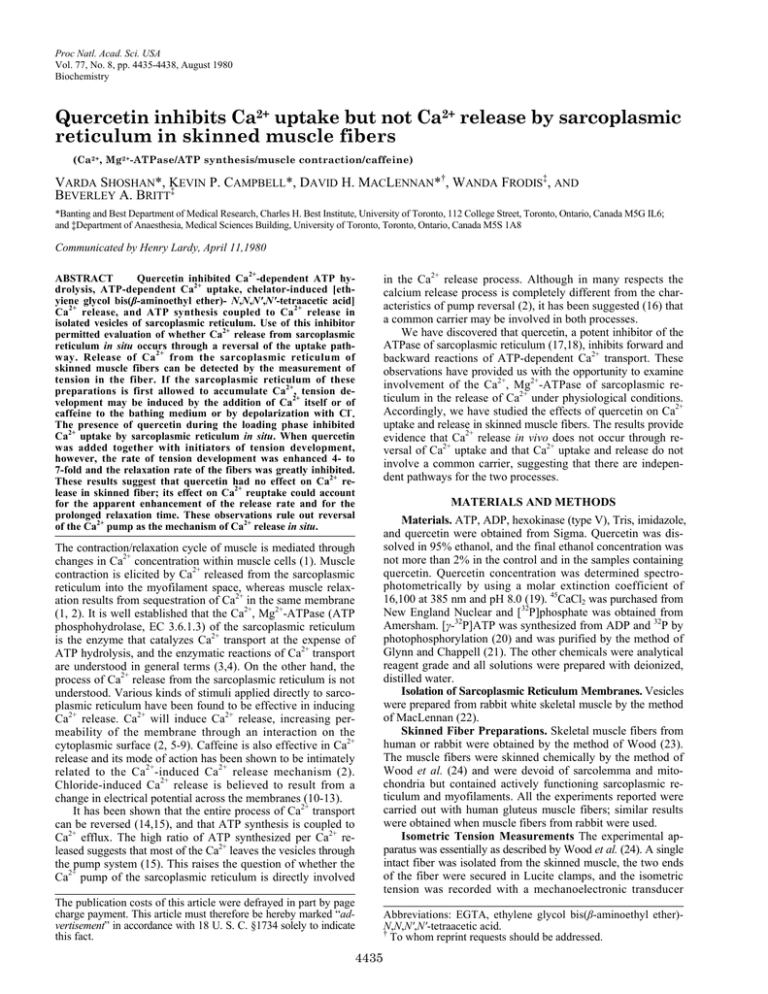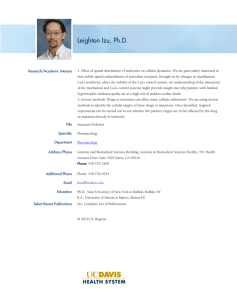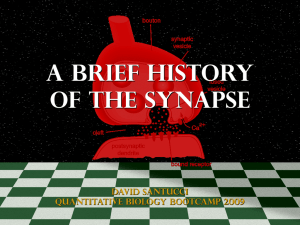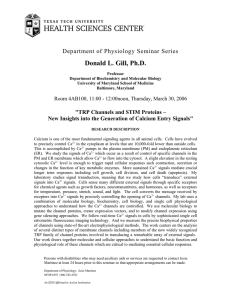Quercetin inhibits Ca2+ uptake but not Ca2+ release by
advertisement

Proc Natl. Acad. Sci. USA Vol. 77, No. 8, pp. 4435-4438, August 1980 Biochemistry Quercetin inhibits Ca2+ uptake but not Ca2+ release by sarcoplasmic reticulum in skinned muscle fibers (Ca2+, Mg2+-ATPase/ATP synthesis/muscle contraction/caffeine) VARDA SHOSHAN*, KEVIN P. CAMPBELL*, DAVID H. MACLENNAN*†, WANDA FRODIS‡, AND BEVERLEY A. BRITT‡ *Banting and Best Department of Medical Research, Charles H. Best Institute, University of Toronto, 112 College Street, Toronto, Ontario, Canada M5G IL6; and ‡Department of Anaesthesia, Medical Sciences Building, University of Toronto, Toronto, Ontario, Canada M5S 1A8 Communicated by Henry Lardy, April 11,1980 ABSTRACT Quercetin inhibited Ca2+-dependent ATP hydrolysis, ATP-dependent Ca2+ uptake, chelator-induced [ethyiene glycol bis(β-aminoethyl ether)- N,N,N′,N′-tetraacetic acid] Ca 2+ release, and ATP synthesis coupled to Ca 2+ release in isolated vesicles of sarcoplasmic reticulum. Use of this inhibitor permitted evaluation of whether Ca2+ release from sarcoplasmic reticulum in situ occurs through a reversal of the uptake pathway. Release of Ca 2+ from the sarcoplasmic reticulum of skinned muscle fibers can be detected by the measurement of tension in the fiber. If the sarcoplasmic reticulum of these preparations is first allowed to accumulate Ca2+, tension development may be induced by the addition of Ca2+ itself or of caffeine to the bathing medium or by depolarization with Cl-. The presence of quercetin during the loading phase inhibited Ca2+ uptake by sarcoplasmic reticulum in situ. When quercetin was added together with initiators of tension development, however, the rate of tension development was enhanced 4- to 7-fold and the relaxation rate of the fibers was greatly inhibited. These results suggest that quercetin had no effect on Ca2+ release in skinned fiber; its effect on Ca2+ reuptake could account for the apparent enhancement of the release rate and for the prolonged relaxation time. These observations rule out reversal of the Ca2+ pump as the mechanism of Ca2+ release in situ. in the Ca2+ release process. Although in many respects the calcium release process is completely different from the characteristics of pump reversal (2), it has been suggested (16) that a common carrier may be involved in both processes. We have discovered that quercetin, a potent inhibitor of the ATPase of sarcoplasmic reticulum (17,18), inhibits forward and backward reactions of ATP-dependent Ca2+ transport. These observations have provided us with the opportunity to examine involvement of the Ca2+, Mg2+-ATPase of sarcoplasmic reticulum in the release of Ca2+ under physiological conditions. Accordingly, we have studied the effects of quercetin on Ca2+ uptake and release in skinned muscle fibers. The results provide evidence that Ca2+ release in vivo does not occur through reversal of Ca2+ uptake and that Ca2+ uptake and release do not involve a common carrier, suggesting that there are independent pathways for the two processes. MATERIALS AND METHODS Materials. ATP, ADP, hexokinase (type V), Tris, imidazole, and quercetin were obtained from Sigma. Quercetin was dissolved in 95% ethanol, and the final ethanol concentration was not more than 2% in the control and in the samples containing quercetin. Quercetin concentration was determined spectrophotometrically by using a molar extinction coefficient of 16,100 at 385 nm and pH 8.0 (19). 45CaCl2 was purchased from New England Nuclear and [32P]phosphate was obtained from Amersham. [γ-32P]ATP was synthesized from ADP and 32P by photophosphorylation (20) and was purified by the method of Glynn and Chappell (21). The other chemicals were analytical reagent grade and all solutions were prepared with deionized, distilled water. Isolation of Sarcoplasmic Reticulum Membranes. Vesicles were prepared from rabbit white skeletal muscle by the method of MacLennan (22). Skinned Fiber Preparations. Skeletal muscle fibers from human or rabbit were obtained by the method of Wood (23). The muscle fibers were skinned chemically by the method of Wood et al. (24) and were devoid of sarcolemma and mitochondria but contained actively functioning sarcoplasmic reticulum and myofilaments. All the experiments reported were carried out with human gluteus muscle fibers; similar results were obtained when muscle fibers from rabbit were used. Isometric Tension Measurements The experimental apparatus was essentially as described by Wood et al. (24). A single intact fiber was isolated from the skinned muscle, the two ends of the fiber were secured in Lucite clamps, and the isometric tension was recorded with a mechanoelectronic transducer The contraction/relaxation cycle of muscle is mediated through changes in Ca2+ concentration within muscle cells (1). Muscle contraction is elicited by Ca2+ released from the sarcoplasmic reticulum into the myofilament space, whereas muscle relaxation results from sequestration of Ca2+ in the same membrane (1, 2). It is well established that the Ca2+, Mg2+-ATPase (ATP phosphohydrolase, EC 3.6.1.3) of the sarcoplasmic reticulum is the enzyme that catalyzes Ca2+ transport at the expense of ATP hydrolysis, and the enzymatic reactions of Ca2+ transport are understood in general terms (3,4). On the other hand, the process of Ca2+ release from the sarcoplasmic reticulum is not understood. Various kinds of stimuli applied directly to sarcoplasmic reticulum have been found to be effective in inducing Ca2+ release. Ca2+ will induce Ca2+ release, increasing permeability of the membrane through an interaction on the cytoplasmic surface (2, 5-9). Caffeine is also effective in Ca2+ release and its mode of action has been shown to be intimately related to the Ca2+-induced Ca 2+ release mechanism (2). Chloride-induced Ca2+ release is believed to result from a change in electrical potential across the membranes (10-13). It has been shown that the entire process of Ca2+ transport can be reversed (14,15), and that ATP synthesis is coupled to Ca2+ efflux. The high ratio of ATP synthesized per Ca2+ released suggests that most of the Ca2+ leaves the vesicles through the pump system (15). This raises the question of whether the Ca2+ pump of the sarcoplasmic reticulum is directly involved The publication costs of this article were defrayed in part by page charge payment. This article must therefore be hereby marked “advertisement” in accordance with 18 U. S. C. §1734 solely to indicate this fact. 4435 Abbreviations: EGTA, ethylene glycol bis(β-aminoethyl ether)N,N,N′,N′-tetraacetic acid. † To whom reprint requests should be addressed. 4436 Biochemistry: Shoshan et al. Proc. Natl. Acad. Sci. USA 77 (1980) (Grass Instrument, model FT O3C) and a Gould Brush 2200 recorder. The maximal isometric tension was determined by exposing the fiber to 10 µM free Ca2+. The experiments were carried out at 22° C in a thermoregulated chamber. Assays. ATPase activity was determined at 37° C as described (22). The 32 P released from [γ- 32 P]ATP was extracted as phosphomolybdate with isobutanol/benzene, 1:1 (vol/vol), by the method of Avron (20) and measured by liquid scintillation counting. Ca2+ uptake was assayed as described (22) by the Millipore filtration method (25). Protein concentration was determined according to Lowry et al. (26) with bovine serum albumin as a standard. The concentration of free Ca2+ in the Ca 2+ /ethylene glycol bis(β-aminoethyl ether)- N,N,N′,N′tetraacetic acid (EGTA) buffers was calculated by assuming an association constant of 2 × 106 M-1 at pH 7.0. RESULTS Quercetin Inhibition of ATPase Activity and Ca2+ Uptake in Isolated Sarcoplasmic Reticulum Vesicles. Quercetin, a flavonoid, has been reported to inhibit the activity of enzymes involved in energy conversion reactions (17-19, 27-29). Quercetin inhibited Ca2+-dependent ATPase activity and Ca2+ uptake by sarcoplasmic reticulum membranes (Table 1). In these experiments, half-maximal inhibition was obtained with about 10 µM quercetin. The effective range of quercetin concentration, however, increased with increasing protein concentration (not shown). Effect of Quercetin on the Reversal of Ca2+ Pump. It has been shown (14,15) that, when sarcoplasmic reticulum vesicles previously loaded with Ca2+ are incubated in medium containing ADP, Pi, Mg2+, and EGTA, stored Ca2+ is released to the medium and Ca2+ efflux is coupled to ATP synthesis. Under the proper conditions for reversal of the Ca2+ pump, quercetin inhibited both ATP synthesis and Ca2+ release (Fig. 1). Some Ca2+ release was not coupled to ATP synthesis and was resistant to quercetin. Thus, the Ca2+ released per ATP synthesized was 2.3 rather than 2.0 as anticipated for perfect coupling. Effect of Quercetin on Ca2+ Uptake by Sarcoplasmic Reticulum in Skinned Muscle Fibers. The inactivation of the Ca 2+-ATPase by quercetin and the inhibition, thereby, of ATP-driven Ca2+ uptake and the reversal of this process can be used to test the relationship between the reversal of the Ca2+ pump and Ca2+ release in muscle fibers. The effect of quercetin on Ca2+ movement between the sarcoplasmic reticulum and the myofilament space was studied in skinned muscle fibers by using isometric force as an indicator of Ca2+ release from the sarcoplasmic reticulum. In the experiment described in Fig. 2, the sarcoplasmic reticulum in the fiber was loaded with Ca2+ in the absence or presence of quercetin at the concentration Table 1. Effect of quercetin on ATPase and Ca2+ uptake activities Of isolated sarcoplasmic reticulum ATPase activity, Ca2+ uptake, Quercetin µmol/mg protein µmol/mg protein None 12.47 1.454 7 µM 9.30 1.279 15 µM 3.25 0.518 30 µM 0.63 0.087 ATPase and Ca2+ uptake activities were assayed for 4 min. The reaction mixture for ATPase activity contained 20 mM Tris-HCl at pH 7.5,100 mM KC1, 5 mM MgCl2 5 mM [γ32-P]ATP (containing 1.5 × 105 cpm/µmol), 0.5 mM EGTA, 0.5 mM CaCl2, and sarcoplasmic reticulum at 40 µg/ml. Conditions for Ca2+ uptake were the same as for ATPase activity, except that 5 mM K oxalate was added to the reaction mixtures, unlabeled ATP was used, and 45CaCl2 was added to a specific activity of 5 × 106 cpm/µmol. FIG. 1. Inhibition of reversal of the Ca2+ pump by quercetin. Ca2+ release (Upper) and ATP synthesis (Lower) were measured with Ca2+-loaded vesicles. The loading solution for Ca2+ uptake was as described in Table 1 except that 45Ca, to a specific activity of 107 cpm/µmol, was added only to the vesicles used for measurement of Ca2+ release. After.30 min at 22°C the vesicles were centrifuged at 80,000 × g for 20 min and the pellets were resuspended in 20 mM Tris-HCl, pH 7.5/100 mM KCl and used immediately. ATP synthesis and Ca2+ release were assayed in a medium containing 20 mM Tris maleate at pH 6.5,2 mM EGTA, 6 mM phosphate, 20 mM MgCl2,20 mM glucose, 0.5 mM ADP, 10 units ofhexokinase per ml, and 100 µg of loaded vesicles per ml 32P (8.8 × 106 cpm/µmol) was added when ATP synthesis was measured. [32P] Phosphate was extracted as described (20) and the glucose 6-phosphate formed in the reaction was measured by liquid scintillation counting. Ca2+ release was determined from the amount of 45Ca retained in the filter (25). The quercetin concentration was 200 µM. indicated. Then the fiber was washed§ and the tension response was elicited by the addition of 10 mM caffeine. The amplitude of the caffeine-induced tension was plotted against quercetin concentration in the loading step. Quercetin decreased the tension amplitude, presumably because it inhibited prior Ca2+ accumulation by the sarcoplasmic reticulum. The range of quercetin concentrations required to bring about inhibition of tension development varied somewhat from fiber to fiber but was usually lower than that presented in Fig. 2 (see Fig. 3, where inhibition of relaxation and presumably of Ca2+ reuptake was complete at 100 µM quercetin). Effect of Quercetin on Caffeine-Induced Ca2+ Release from Sarcoplasmic Reticulum. In order to test the effect of quercetin on Ca2+ release, quercetin was added to the caffeine solution. Fig. 3 shows the force spikes obtained with or without quercetin in the caffeine solution. In caffeine solution without quercetin, the force increased to a maximum and then declined due to calcium reuptake by sarcoplasmic reticulum. With ad§ Quercetin can be removed by washing in aqueous solution. This is shown by the ability of the washed fiber to reload Ca2+ and to redevelop tension if the fiber is washed after exposure to quercetin. Biochemistry: Shoshan et al. Proc. Natl. Acad. Sci. USA 77 (1980) 4437 Table 2. Effect of quercetin on level and rate of change of caffeine-induced tension Tension Quercetin, µM mg mg/sec 0 101.3 7.0 50 100 17.5 100 103.8 25.6 150 106.8 33.8 200 112.2 45.0 The experiments were performed as described in Fig. 2, except that quercetin, at the indicated concentrations, was present in the wash solution containing 10 mM caffeine. The chart speed was increased to determine the rates of tension development more precisely. The rates were calculated from the linear part of the responses, which was about 80% of the maximal tension. FIG. 2. Effect of quercetin on Ca2+ loading by sarcoplasmic reticulum in skinned, single fiber (diameter, 75 µm). The sarcoplasmic reticulum was loaded with Ca2+ by exposing the fiber for 30 sec to a wash solution (5 mM imidazole/2.5 mM ATP/2.5 mM MgO/185 mM K propionate, pH 7.0) containing 5 mM EGTA, 0.158 µM free Ca2+, and the indicated concentrations of quercetin. The fiber was then rinsed twice with wash solution. To elicit a tension response, wash solution containing 10 mM caffeine was added. The fiber was relaxed with wash solution containing 5 mM EGTA followed by wash solution containing 40 mM caffeine (to empty the vesicles) and then rinsed twice with wash solution. The fiber was then reloaded with Ca2+ as described above. Usually, 6-10 cycles of Ca2+ uptake and release were obtained with a fiber and the maximum tension decreased only by about 10% during the course of the experiments. dition of 50 µM quercetin, the rate of tension development increased and relaxation was inhibited. Increasing the quercetin concentration to 100 µM caused a further increase in the rate of tension development and completely prevented the relaxation of the fiber. The inhibitory effect of quercetin on the relaxation of the fiber was consistent with the concept that relaxation is due to reaccumulation of calcium by the sarcoplasmic reticulum. The transient nature of the tension may thus reflect the dynamic equilibrium between uptake and release of Ca2+ by the sarcoplasmic reticulum and may explain the positive effect of quercetin on the rate of tension development (Table 2). Addition of 100-200 µM quercetin alone to Ca2+loaded fibers caused a slow increase in tension (about 0.5 mg/sec after an initial lag). This increased tension probably resulted from passive leakage of Ca2+ from sarcoplasmic re- ticulum when the Ca2+ uptake system was inhibited by quercetin. Quercetin had no effect on the activity of the contractile proteins themselves because the tension developed by direct exposure of an unloaded fiber to 10 µM free Ca2+ was not affected by quercetin (data not shown). In addition, the effects of quercetin described above were completely reversible when the fiber was washed (see legend to Fig. 2). Effect of Quercetin on Tension Development Induced by Chloride and Calcium. Muscle fiber contraction can be induced by various calcium release stimuli (6-8,10-13). In order to induce Ca2+ efflux from the loaded sarcoplasmic reticulum by depolarization of the internal membrane, K propionate was replaced by KCl. We found that high concentrations of free Mg2+ inhibited the chloride-induced Ca2+ release, in confirmation of a previous report (13). Accordingly, the MgCl2 concentration was reduced from 2.5 mM to 0.5 mM; the effect of quercetin on the chloride-induced tension development was similar to that found with caffeine (Table 3). Quercetin also increased the rate of tension development induced by the addition of Ca2+ to the bathing medium. In this case the MgCl2 concentration in the bathing solution was also reduced (30). It seems, therefore, that the effect of quercetin on tension development was not dependent on the specific stimulus used. DISCUSSION The mechanism that initiates Ca2+ release and the molecular mechanism of Ca2+ release from sarcoplasmic reticulum are still not understood. Our study, directed toward the molecular mechanism of Ca2+ release, concerned the relationship between Table 3. Effect of quercetin on the Ca2+ release induced by various stimuli Tension Ca2+ release Relaxation, induced by mg/sec mg mg/sec Caffeine Caffeine + quercetin KCl KCl + quercetin Calcium Calcium + quercetin FIG. 3. Effect of quercetin on the response of a skinned fiber to caffeine. The experiments were carried out as described in Fig. 2, except that the fiber diameter was 62 µM and, where indicated, quercetin was added to the wash solution containing 10 mM caffeine. 64 90 46 62 38 50 17 64 20 64 22 68 10 1 7 >1 28 2 Experimental conditions were as in Table 2, except that for chloride-induced Ca2+ release, K propionate was replaced by KCl and 2.5 mM MgO was replaced by 0.5 mM MgCl2 in the wash solution. For the Ca2+-induced Ca2+ release, Ca/EGTA solutions were added to the wash solution in which MgO was replaced by 0.5 mM MgCl2. The free Ca2+ concentration was 0.2 µM and this concentration had no effect on the unloaded fiber. The same results with caffeine-induced Ca2+ release were obtained when the caffeine solution contained 0.5 mM MgCl2. The quercetin concentration was 200 µM and the fiber diameter was 62 µm. 4438 Biochemistry: Shoshan et al. Ca2+ uptake and Ca2+ release and used quercetin as an inhibitor of the Ca 2+ ATPase. The present findings show that quercetin inhibits Ca2+ ATPase and Ca2+ uptake activities of the sarcoplasmic reticulum in isolated membranes and in skinned fibers (Table 1; Fig. 2). One Ca2+ release mechanism is that represented by the reversal of ATP-dependent Ca 2+ uptake. We have shown, by using isolated sarcoplasmic reticulum (Fig. 1), that quercetin inhibits Ca2+ release and ATP synthesis concomitantly. Thus, if Ca2+ release in the muscle cells, under physiological conditions, were due to reversal of the Ca2+ pump, one would expect that quercetin would be an inhibitor of the physiologically relevant Ca2+ release. Analysis of the effect of quercetin on Ca2+ release from the sarcoplasmic reticulum in skinned fibers shows that Ca2+ release is not affected by quercetin (Fig. 3; Table 2). The Ca2+ release mechanisms induced by caffeine, Ca2+, or Cl- are believed to be different from the reversal of the Ca2+ pump because the characteristics of pump reversal are different from those of Ca2+ release elicited by the various inducers. For example, external free Ca2+ inhibits pump reversal (14, 31) and stimulates Ca 2+ release. Moreover, external free Mg 2+ is required for pump reversal but has an inhibitory effect on Ca2+ release (30). In addition, the requirement for ADP and phosphate for reversal of the Ca2+ pump and its inhibition by ATP (14, 31) are exactly the opposite of the conditions required for Ca2+ release (2). It is possible, however, that the carrier for the pump might be uncoupled from the ATP-splitting system under certain conditions and act as a carrier for Ca2+ release. This suggestion is inconsistent with the results in Table 2 and Fig. 3 which indicate that ATPase is active in transporting Ca 2+ during the period of Ca2+ release. This conclusion is deduced from the marked increase in the rate of Ca 2+ release under conditions such that the Ca2+ ATPase was inactive. This increase in the rate of Ca2+ release is a reflection of the dynamic equilibrium between the uptake and release of Ca 2+ under conditions which elicited Ca2+ release; inhibition of Ca2+ uptake by quercetin results in an apparent stimulation in the rate of Ca2+ release. Ogawa and Ebashi (16) found that the ATP analogue AMPOPCP inhibited the Ca2+ pump and at the same time enhanced Ca 2+ -induced Ca 2+ release, both with similar affinities. They suggested that a common carrier is active in both the release and the uptake of Ca2+. Their results, like our results with quercetin, can be explained, however, by an inhibition of Ca2+ uptake which results in a change in the equilibrium between the release and uptake of Ca 2+ , thereby leading to an apparent stimulation of Ca2+ release. The use of skinned muscle fibers for the study of Ca2+ release for sarcoplasmic reticulum has limitations because connections between the surface membrane and the sarcoplasmic reticulum are disrupted and electrical stimulation no longer elicits Ca2+ release. We have examined the effect of quercetin on whole muscle fibers that were electrically excitable and found no inhibition of the electrically stimulated twitches. In these experiments we could not prove that quercetin was penetrating to intracellular sites but we could deduce that it did not act at the cell surface to prevent excitation-contraction coupling. We are grateful to Dr. Donald Wood for his advice regarding the measurement of tension development in skinned fibers. V.S. is a Proc. Natl. Acad. Sci. USA 77 (1980) Postdoctoral Fellow of the Muscular Dystrophy Association of Canada; K.P.C. is a Postdoctoral Fellow of the Medical Research Council of Canada. This research was supported by Grant MT-3399 from the Medical Research Council of Canada and a grant from the Muscular Dystrophy Association of Canada to D.H.M. and by Grant MA-5765 from the Medical Research Council of Canada and a grant from the Muscular Dystrophy Association of Canada to B.A.B. This is paper 14 in a series “Resolution of Enzymes of Biological Transport.” 1. 2. 3. 4. 5. 6. 7. 8. 9. 10. 11. 12. 13. 14. 15. 16. 17. 18. 19. 20. 21. 22. 23. 24. 25. 26. 27. 28. 29. 30. 31. Ebashi S. & Endo, M. (1968) Progr. Biophys. Mol. Biol. 18, 123-183. Endo, S. (1977) Physiol. Rev. 57,71-108. De Meis, L. & Vianna, A. L. (1979) Annu. Rev. Biochem. 48, 275-279. Hasselbach, W. (1978) Biochim. Biophys. Acta 515,23-53. Endo, M., Tanaka, M. & Ogawa, Y. (1970) Nature (London) 228, 34-36. Ford, L. E. & Podolsky, R. J. (1972) J. Physiol. (London) 233, 218-221. Fabiato, A. & Fabiato, F. (1975) J. Physiol. (London) 249, 469-495;497-515. Ford, L. E. & Podolsky, R. J. (1978) J. Physiol. (London) 276, 233-255. Katz, A. M., Repke, D. I., Fudyma, G. & Shigekawa, M. (1977) J. Biol. Chem. 252,4210-4214. Constantin, L. L. & Podolsky, R. J. (1967) J. Gen. Physiol. 50, 1101-1124. Ford, L. E. & Podolsky, R. J. (1970) Science 167,58-59. Nakajima, Y. & Endo, M. (1973) Nature (London) New Biol. 246, 216-218. Stephenson, E. W. & Podolsky, R. J. (1977) J. Gen. Physiol. 69, 17-35. Barlogie, B., Hasselbach, W. & Makinose, M. (1971) FEBS Lett. 12,267-268;269-270. Panet, R. & Selinger, Z. (1972) Biochim. Biophys. Acta 255, 34-42. Ogawa, Y. & Ebashi, S. (1976) J. Biochem. 80,1149-1157. Fewtrell, C. M. S. & Gomperts, B. D. (1977) Nature (London) 265,635-636. Suolina, E.-M., Buchsbaum, R. N. & Packer, E. (1975) Cancer Res. 35,1865-1872. Cantley, L. C., Jr. & Hammes, G. G. (1976) Biochemistry 15, 1-8. Avron, M. (1960) Biochim. Biophys. Acta 40,257-272. Glynn, I. M. & Chappell, J. B. (1964) Biochem. J. 90, 147149. MacLennan, D. H. (1970) Biol. Chem. 245,4508-4518. Wood, D. S. (1978) Exp. Neurol. 58,218-230. Wood, D. S., Zollman, J., Reuben, J. P. & Brandt, P. W. (1975) Science 187,1075-1076. Martonosi, A. & Feretos, R. (1964) J. Biol. Chem. 239, 648658. Lowry, O. H., Rosebrough, N. J., Farr, A. L. & Randall, R. J. (1951) J. Biol. Chem. 193,265-275. Lang, D. R. & Backer, E. (1974) Biochim. Biophys. Acta 333, 180-186. Stenlid, G. (1970) Phytochemistry 9,2251-2256. Shoshan, V., Shahak, Y. & Shavit, N. (1980) Biochim. Biophys. Acta 591,421-433. Stephenson, E. W. & Podolsky, R. J. (1977) J. Gen. Physiol. 69, 1-16. Yamada, S., Sumida, M. & Tonomura, Y, (1972) J. Biol. Chem. 72,1537-1548.



